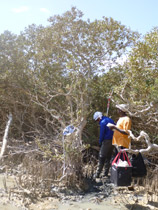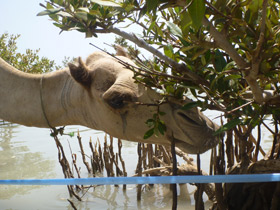- Characteristics of morphological adaptation of Avicennia marina by environmental stress on the Red Sea Coast, Sudan
(2012/2/25~2012/3/21、Sudan)
Grad. School of Systems Engineering,Wakayama university /student,Taiji Murakami
We went to Red Sea coast of Sudan to investigate morphological characteristics of Avicennia marina which is a type of mangrove growing along the Red Sea coast.We collected shoots and leaves of Avicennia marina with the support of Red Sea University.The aims of this study has three points.First is to investigate the morphological flexibility of Avicennia marina growing under severe stress such as high salinity, drought and hard soil conditions.Second is to investigate the suitable condition of the growth of Avicennia marina in the Red Sea area.Third is to investigate the good effects on the growth of Avicennia marina brought by camel grazing.For these purposes, I decided on the sampling site, Kiranaib which is reported that there are a lot of Avicennia marina under grazing pressure by camels.When we selected the subject tree, we classified them into four groups under grazing pressure by camels.We sampled 6759 leaves from 1359 shoots from 52 trees.In regard to the subject of trees, we measured the height of trees, the width trees, the salinity of sea water and the diameter of trunks, counted the number of shoots and leaves per tree.About 6-8 points were sampled, though the number of sample per tree was different depending on the tree height.Moreover, we sampled about 5 shoots and 25 leaves every point.Then, we also measured height and width of sampling points.We measured leaf area, the number of leaves a shoot, the thickness of leaves, the greenness of leaves, dry weight of leaves and shoots, the internode length, the number of nodal and shoot length.We will compare these results according to the type of trees and height and width of sampling, investigate characteristics of morphological adaptation of Avicennia marina by environmental stress.
 ▲The camel eating Avicennia marina |
 ▲The state of field survey |